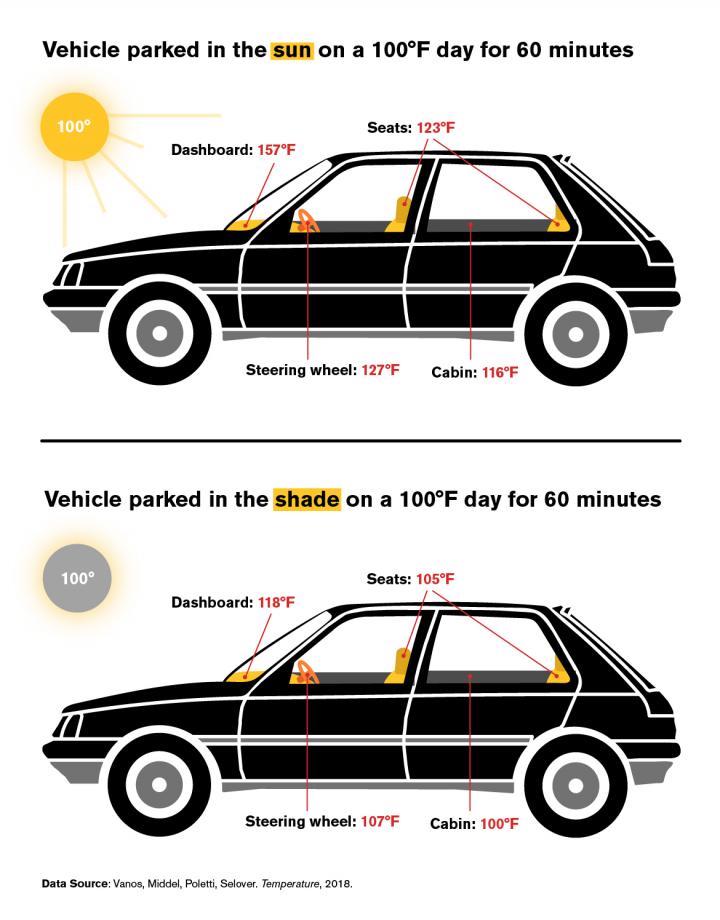How Long Does It Take a Parked Car to Reach Deadly Hot Temperatures?


It's well known that a car parked outside on a hot summer's day can turn into a scorching oven. But how fast does it take the inside of a car to heat up to deadly temperatures?
The answer can be a matter of life and death. Every year in the United States, an average of 37 children die after being left in hot cars, according to researchers of a new study, published online today (May 24) in the journal Temperature.
To investigate the matter, researchers studied how long it takes different types of cars to heat up on hot days. The findings were sobering: Within 1 hour, the temperature inside of a car parked in the sun on a day that reached 95 degrees Fahrenheit (35 degrees Celsius) or hotter, hit an average of 116 degrees F (47 degrees C). [Why Does Being in the Heat Make Us Feel Tired?]
The cars' dashboards got even hotter, reaching 157 degrees F (69 degrees C), on average; the steering wheels climbed to a temperature of 127 degrees F (53 degrees C), on average; and the temperature of the seats hit 123 degrees F (51 degrees C), on average.
Cars parked in the shade on a hot day had lower — but still scorching — temperatures. After 1 hour, the interior temperature of these cars reached an average of 100 degrees F (38 degrees C). The dashboards of these cars averaged 118 degrees F (48 degrees C); the steering wheel averaged 107 degrees F (42 degrees C); and the seats averaged 105 degrees F (41 degrees C), the researchers found.
"We've all gone back to our cars on hot days and have been barely able to touch the steering wheel," study co-researcher Nancy Selover, a climatologist at Arizona State University, said in a statement. "But, imagine what that would be like to a child trapped in a car seat." (More on this later.)
Selover added that anybody sitting in such a car would, of course, breathe, and that each breath would introduce humidity into the vehicle.
Get the world’s most fascinating discoveries delivered straight to your inbox.
"They are exhaling humidity into the air," Selover said. "When there is more humidity in the air, a person can't cool down by sweating because sweat won't evaporate as quickly."
The researchers used six vehicles in the study: Two identical silver economy cars, two identical silver midsize sedans and two identical silver minivans. Then, on three different summer days in Tempe, Arizona, they monitored the parked cars in both sunny and shady locations.
"These tests replicated what might happen during a shopping trip," Selover said. "We wanted to know what the interior of each vehicle would be like after one hour, about the amount of time it would take to get groceries. I knew the temperatures would be hot, but I was surprised by the surface temperatures."
Unsurprisingly, the cars heated at different rates. The economy car warmed faster than the midsize sedan and the minivan, the researchers found.
Children in cars
A person trapped in a rapidly heating car is at risk for heatstroke, which can be deadly.
It's difficult to predict when heatstroke will strike — largely because the condition involves many factors, including a person's age, weight and existing health conditions, the researchers said. But most cases happen when a child's core body temperature rises above 104 degrees F (40 degrees C) for an extended period of time. [What is Heat Stroke?]
To learn more about the risks children face, the researchers used data to model a hypothetical 2-year-old boy. When strapped into a car seat in a parked car on a hot day, this child would meet the criteria for heatstroke in just 1 hour if the car were parked in the sun and 2 hours if the car were parked in the shade, the researchers found.
"We hope these findings can be leveraged for the awareness and prevention of pediatric vehicular heatstroke and the creation and adoption of in-vehicle technology to alert parents of forgotten children," the study's lead researcher, Jennifer Vanos, an assistant professor of climate and human health at the University of California, San Diego, said in the statement.
Vanos added that effects from hyperthermia (having a higher-than-normal body temperature) and heatstroke happen along a continuum, from internal injuries to brain and organ damage.
Original article on Live Science.

Laura is the managing editor at Live Science. She also runs the archaeology section and the Life's Little Mysteries series. Her work has appeared in The New York Times, Scholastic, Popular Science and Spectrum, a site on autism research. She has won multiple awards from the Society of Professional Journalists and the Washington Newspaper Publishers Association for her reporting at a weekly newspaper near Seattle. Laura holds a bachelor's degree in English literature and psychology from Washington University in St. Louis and a master's degree in science writing from NYU.



